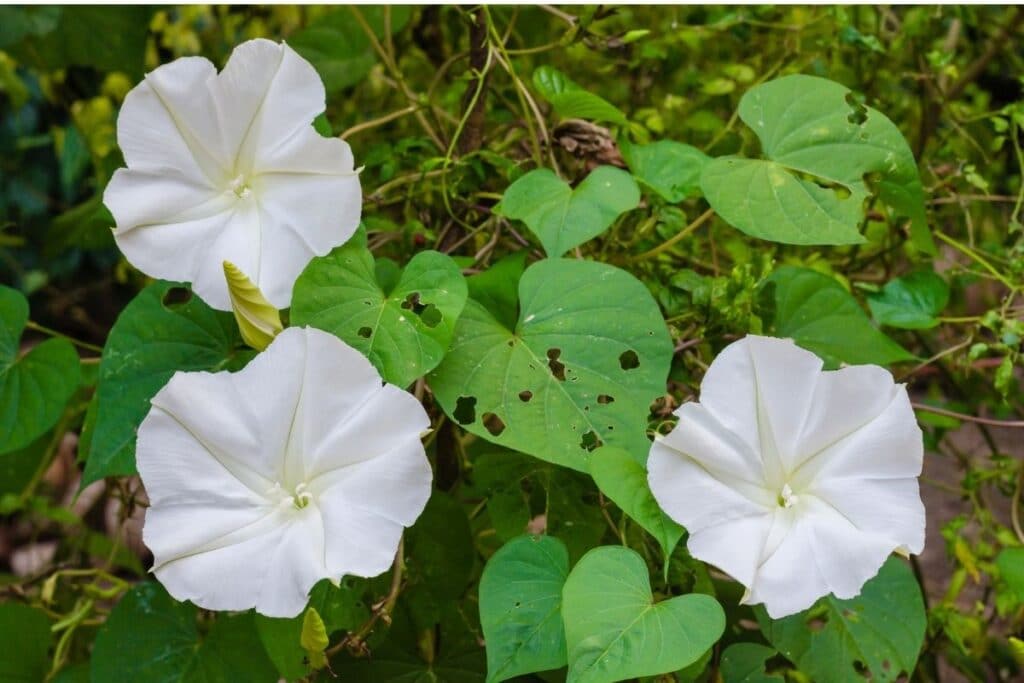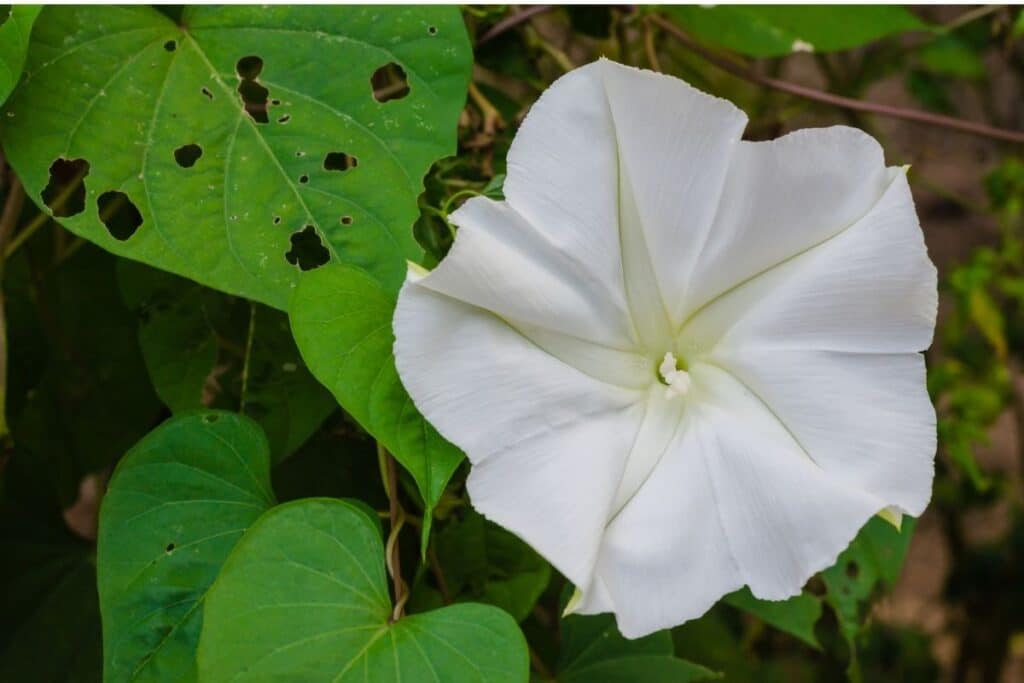Ipomoea alba, commonly known as the Moonflower, is a vine with white fragrant flowers and heart-shaped leaves. From its scientific name, alba is Latin for white. This is an easy way to remember its flowers being white.
The unique appearance of the vine and how the flowers bloom during sunset and in full bloom at night will surely catch your attention. Also, its flowers will surely make the ambiance of any space better, as long as it is properly grown and maintained.
Below are the details you need to optimize your moonflower’s potential.
Botanical Information
The Moonflower, Ipomoea alba formerly known as Calonyctic aculeatum, also comes by the names tropical white morning-glory, thornapple, giant white moonflower, evening glory, devil’s trumpet, moon creeper, jimsonweed, and moon vines.
It comes from the Convolvulaceae family and is native in North America, South America, and Central America. USDA zones 10 to 12 is where this plant flourishes best.
Leaves
The shape of the vine’s leaves adds to its overall aesthetic. Having green leaves that can grow up to 8 inches and takes a shape that resembles a heart makes moonflower vine more appealing to people.

Flowers
The flower of moonflower has elongated petals that are merged in the base. As one of the common types of white flowers, it is a white slender tube-like flower that forms a star-like pattern by the petals’ intersection when viewed from above. The star formed is noticeable because of its slightly yellowish pigment. Also, the fragrant and showy flowers help improve the overall aesthetics of any landscape.
Furthermore, don’t forget to remove the spent flowers from the vines before they may drop seeds if you don’t want them to reseed in your garden. Additionally, the act of deadheading the vines may encourage additional flowering.
Fruit and Seeds
The fruit of the vine is a brow capsule-like fruit with an inch-long pointed tip. Inside it are four white smooth seeds. The seed of Ipomoea is made up of a hard seed coat. Hence, in germinating the seeds some pre-planting activities should be taken into account.
Growth and Development
This semi-annual vine does not require much attention as it can grow on its own with the help of its modified tuberous roots and its vast production of seeds.
In a year, the moonflower vine can grow for more than 12 feet. Generally, the plant can grow 3 to 6 feet wide and 10 to 15 feet in height. In addition, flowers bloom during the months of June to October or during Summer and Fall.

How to Grow Moonflower Plants
Sun Requirement
Due to its versatility as a vine, it can withstand full sunlight. However, in places wherein exposure to full sunlight is not available, making it bloom will require at least 6 hours of continuous exposure to full sunlight.
Water Requirements
Watering should be done in moderate amounts because overwatering can easily cause root rot. To check the soil moisture, bury your finger at least an inch deep. Then, check if there are soil particles attached to your finger upon removal from the soil.
If there are little to none, it is time to water the plant because the moonflower vines can only withstand drought in short periods.
Temperature and Humidity Requirements
Moonflower plants thrive in warm temperatures (65°F to 85°F) and moderate humidity (50% to 70%) in tropical climates. They can tolerate slightly cooler temperatures but prefer warmth. In drier climates, increase humidity by misting foliage or using a humidifier. Maintaining suitable temperature and humidity levels promotes healthy growth and blooming.
Fertilizer
If the goal is for the vine to produce more flowers, it is recommended to apply fertilizers that are rich in phosphorus.
On the other hand, if the goal is to manage growth and avoid excessive foliage growth, use less nitrogen fertilizer. Fertilizer application can be done monthly or as instructed on the product label.
Soil Requirements
Moonflowers (Ipomoea alba) thrive in well-draining, fertile soil with a pH level ranging from slightly acidic to neutral (around 6.0 to 7.0). The soil should be loose, airy, and rich in organic matter to support healthy growth and blooming. A loamy soil mixture, supplemented with compost or aged manure, provides essential nutrients and promotes robust root development.
Additionally, ensuring adequate drainage prevents waterlogging, which can lead to root rot and other issues. Moonflowers prefer soil that retains moisture without becoming waterlogged, allowing them to flourish and produce their iconic fragrant blooms.
Propagation
Pollens of the flower are thought to be spread by night-flying moths, specifically the large luna moth. The flower and the insect’s long straw-like mouthpart make them compatible.
As the moonflower seeds are produced, their hard seed coat can hinder their germination. Hence, stratification can be done to hasten germination. Slightly scarring the seed coat by clipping it or rub it against sandpaper to make a small opening. Make sure that it is too big which would damage the whole seed, but big enough to serve as a point of entry for water.
After doing so, it is best to plant the seed pods in slightly moist soil placed under indirect sunlight but is warm. Most gardeners plant the seedlings indoors in a container during fall but some do it in spring. Transplanting will be done when the plant’s stem is strong enough to endure outside conditions.
Common Pests and Control Measures
Some of the common insect pests for the moonflowers are hornworms, spider mites, leafminers, Japanese beetles, and aphids. The said insects can cause stunted growth and holes in different parts of the plant.
Insect Pests can be controlled using different insecticides, such as those with active ingredients like azadirachtin and pyrethrins. If the infestation is still low, using soap and oil to clean infected areas can be done.
Make sure to regularly check the moonflower plant and the surrounding vegetation for signs of bacterial disease.
Potential Harm
According to the USDA, the vine did not classify as invasive in any state. However, if grown in a garden with other plants, make sure to prune regularly and remove dead flowers and other plant parts. In doing so, the risk of being a competition will be lessened.
Landscape Uses
The shape and color of the flowers and leaves of moonflowers can add color to the landscape by incorporating it with different man-made structures such as walls, fences, decks, trellises, and gates. It can also be planted in containers or hanging pots.
As one of the beautiful night flowers, it can be placed in the area of the landscape that people use during the late afternoon to night for them to appreciate the beauty of its flowers with their sweet fragrance.
Moonflower Look-Alikes
Similar to the moonflower, Datura innoxia or also known as Downy Thorn Apple can be an alternative. Unlike the Ipomoea, it is a herb that can grow up to 1 meter in height. Another difference that they have is their leaves. The downy thorn apple has simple elliptic leaves with gray trichomes or tiny hairs.
From the same family, Ipomoea leptophylla, known as Bush Moon Flower, and Ipomoea violacea are some of the moonflower’s twin sisters. The only difference is that the bush moonflower and morning glory has purple-colored flowers and are perennial plants.
FAQs
Do moonflowers need full sun?
Moonflowers prefer full sun to partial shade. While they can tolerate some shade, they generally produce more blooms when grown in full sun.
Will moon flowers come back every year?
Yes, Moonflowers are annuals in most regions, meaning they complete their life cycle in one growing season. However, they can reseed themselves under favorable conditions, allowing them to return each year in suitable climates.
Do moonflowers need a trellis?
Yes, Moonflowers benefit from support such as a trellis, fence, or arbor to climb and twine around. Providing a trellis helps keep the vines upright and organized, showcasing the flowers and preventing them from sprawling on the ground.
Is it OK to touch moonflowers?
Yes, Moonflowers are generally safe to touch. However, some individuals may experience skin irritation or allergic reactions upon contact with the plant’s sap or foliage. It’s always a good idea to wash your hands after handling any plant material.
How long do moonflowers last?
Moonflowers typically bloom for one night only, opening in the evening and wilting by morning. However, new blooms may continue to appear throughout the growing season, providing nightly displays of fragrant flowers.
What is the difference Ipomea moonflower and Datura moonflower?
The main difference between Ipomoea moonflower (Ipomoea alba) and Datura moonflower (Datura inoxia) lies in their botanical classification and flower shapes. Ipomoea moonflower belongs to the morning glory family and produces large, fragrant, white flowers that open at night, while Datura moonflower belongs to the nightshade family and produces trumpet-shaped white flowers that also bloom at night.
Final thoughts
In conclusion, moonflower care brings the enchantment of twilight blooms and intoxicating fragrances to gardens and outdoor spaces.
These nocturnal blooms reward care and attention with their mesmerizing white blooms that unfurl under the moonlight, filling the air with their sweet scent.
If you love moon vine, check these fast growing flowering vines you can plant.
*image by wiro.klyngz/depositphotos






